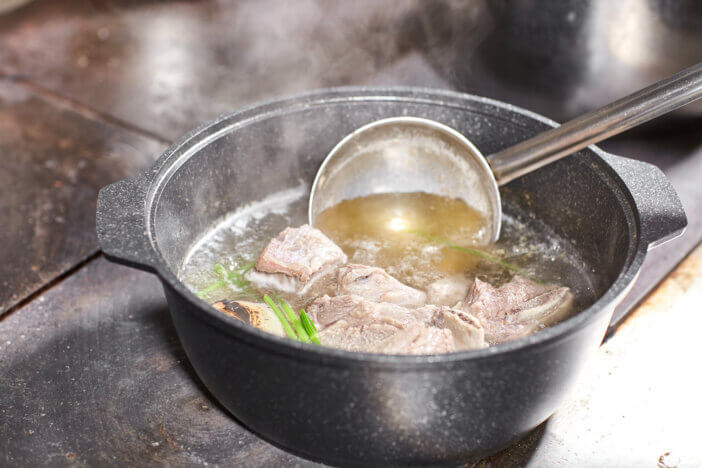8 Bone Stock Recipe Tips to Boost Your Cooking Skills
Craft a flavorful and nutrient-rich bone stock by selecting collagen-rich bones, simmering for at least 6 hours, and adding a touch of acid for depth, resulting in a versatile base for various dishes.

Discover the time-honored tradition of turning bones into a rich and savory stock with these insightful facts. Whether you’re a seasoned chef or a home cook, understanding the nuances of bone stock preparation can elevate your culinary creations to new heights.
Disclosure: As an Amazon Associate, this site earns from qualifying purchases. Thank you!
1. Unveiling Bone Stock Basics

Bone stock is a nutrient-rich liquid made by simmering animal bones and connective tissues in water, often with vegetables, herbs, and spices. This slow-cooking process extracts flavors and nutrients, resulting in a versatile base for soups, sauces, and gravies. Unlike broth, which is typically made with meat and cooked for a shorter period, bone stock is characterized by its depth of flavor and its body, often achieved through a longer simmering time that allows the breakdown of collagen.
2. Selecting Bones for Richer Stock

To achieve a richer and more gelatinous stock, it’s essential to use a mix of bones that have a high concentration of collagen. Knucklebones, joints, and feet are particularly prized for this purpose. These types of bones release collagen as they simmer, which transforms into gelatin, giving the stock its desirable, silky texture. Roasting the bones before simmering can also deepen the flavor profile and add a beautiful caramelized note to your stock.
3. The Role of Bone Marrow in Flavor

Bone marrow plays a significant role in enriching the stock with both flavor and nutrients. Marrow, the fatty substance found in the center of bones, contributes to a fuller, more rounded taste and is packed with vitamins and minerals. When simmering bones for stock, it’s important to include some marrow bones, as the marrow’s richness is released into the liquid, creating a complexity that is hard to replicate with other ingredients.
4. Simmering Secrets: Timing Matters

The length of time bones are simmered is crucial to the quality of the stock. A good bone stock requires patience, as it should simmer for a minimum of 6 to 8 hours, and for even more robust stocks, up to 24 hours or more. This extended simmering time allows for a full extraction of flavors and nutrients, but it is important to maintain a gentle, low simmer to prevent the stock from becoming cloudy and to ensure the flavors remain clean and clear.
5. Acid Adds Depth to Bone Stock

The addition of a mild acid, such as vinegar or wine, to the simmering bones helps to extract calcium and other minerals, enhancing both the nutritional value and the complexity of the flavor. The acid works by breaking down the bone structure, releasing these elements into the stock. It’s important to use the acid sparingly, though, as too much can overpower the natural flavors of the bone stock.
6. The Art of Skimming and Straining
As the stock simmers, impurities and excess fat will rise to the surface, forming a layer of scum. Skimming this off will result in a clearer, more aesthetically pleasing stock. After the stock has finished simmering, straining it through a fine mesh sieve or cheesecloth ensures that the final product is smooth and free of any solid bits, which is especially important for achieving a professional-grade stock.
7. Storing Your Homemade Stock

Proper storage is key to preserving the flavor and freshness of your homemade stock. It can be refrigerated for up to 5 days or frozen for several months. When freezing, consider portioning the stock into ice cube trays or freezer bags, which allows for easy use in future recipes. Always allow the stock to cool to room temperature before storing to prevent bacterial growth.
8. Nutritional Perks of Bone Broth
Bone stock, often referred to as bone broth when consumed on its own, is lauded for its health benefits. It is a source of minerals like calcium, phosphorus, and magnesium, as well as collagen, which is said to support joint health and skin elasticity. Additionally, the amino acids found in bone stock, such as glycine and proline, are believed to aid in digestive health and immune system support.
As Nutritional Weight & Wellness explains in the video –
Nutritional Weight & Wellness
- Bone broth contains glycine which supports better sleep quality, especially when paired with magnesium and calcium also found in bone broth.
- Bone broth is a great source of collagen which strengthens skin elasticity and hydration. Our bodies produce less collagen as we age leading to skin aging.
- While bone broth itself does not directly lead to weight loss, it is high in protein and very filling, so can support weight loss efforts.
- Bone broth contains 10g of protein per cup, supporting muscle tone when paired with adequate exercise.
- Bone broth contains nutrients found in joints – hyaluronic acid, glucosamine, chondroitin, calcium, and magnesium – to support healthy joints.
- The collagen and L-glutamine amino acid in bone broth helps rebuild and support intestinal cells and digestion.
- Bone broth can be incorporated into recipes like ground meat, rice, quinoa, soups, and stews instead of just water or stocks.
- Eating adequate animal protein or taking supplements like collagen, glucosamine and chondroitin can provide similar benefits to bone broth.
- Bone broth’s long simmering time (20+ hours) extracts more nutrients from bones, cartilage and connective tissue compared to eating the meats alone.
- The nutritionist recommends bone broth as part of a healthy diet to support skin, sleep, weight loss, muscle tone, joint, gut, and overall health.
9. Avoiding Common Stock-Making Mistakes

Common stock-making mistakes include boiling the bones too vigorously, which can make the stock cloudy, and adding too many aromatic ingredients, which can overwhelm the natural flavor of the bones. Another mistake is not simmering the stock for a sufficient amount of time, resulting in a thin, lackluster liquid. By avoiding these pitfalls, you can ensure your stock is rich, clear, and full-bodied.
10. Creative Uses for Leftover Stock

Leftover bone stock need not go to waste; it can be the base for a myriad of creative culinary endeavors. Use it to cook grains like rice or quinoa, infuse it into mashed potatoes for added flavor, or reduce it further to create a rich glaze for meats and vegetables. Bone stock can also be used as a warm, soothing drink, seasoned with herbs and spices to suit your taste.
Crafting a homemade stock from bones is both an art and a science, blending tradition with technique for a result that’s as nourishing as it is delicious. With these facts in hand, you’re well-equipped to make the most of your bones and elevate your cooking with the deep, rich flavors of a well-made stock.






